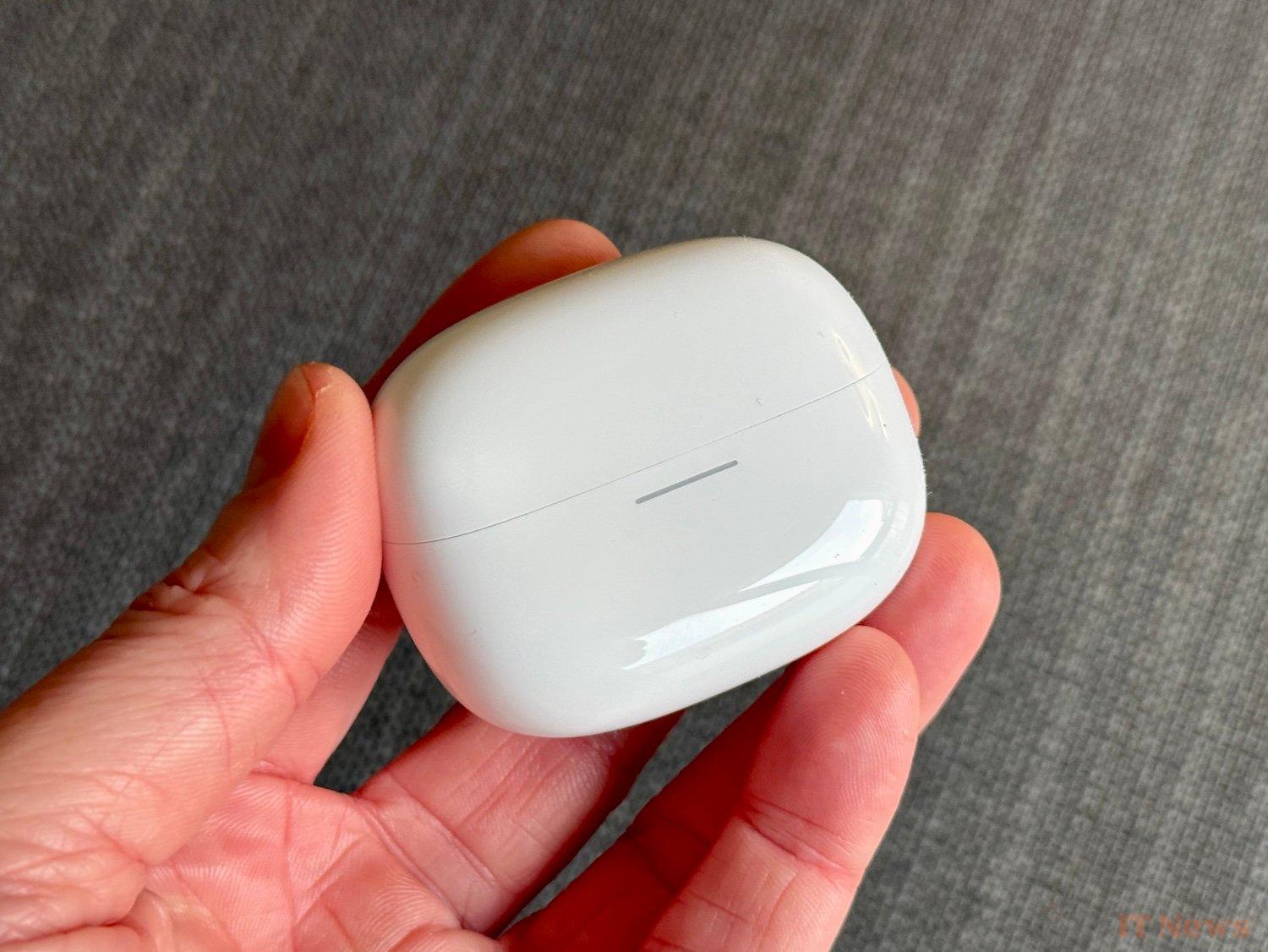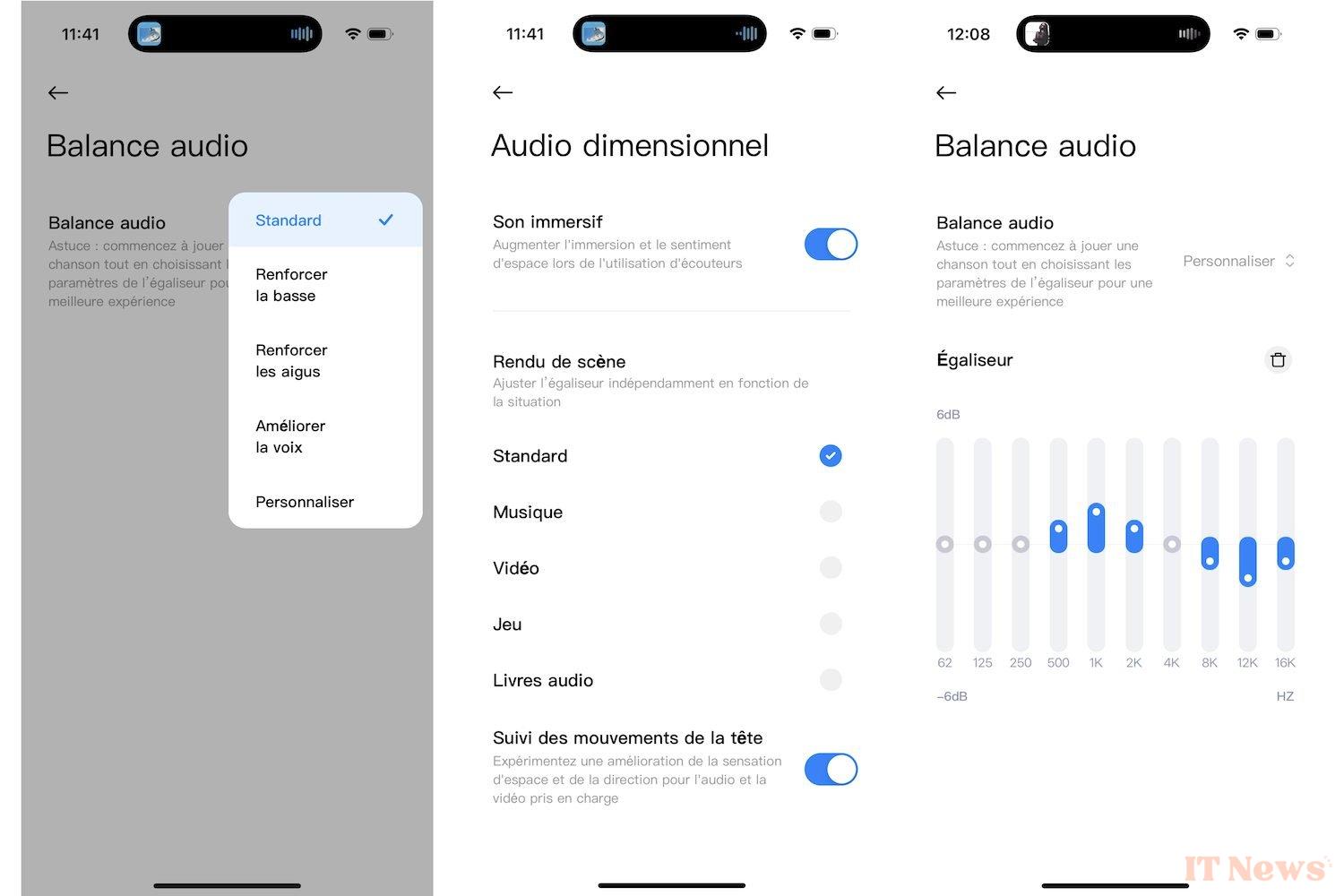Xiaomi continues to hammer home the idea of well-equipped and very affordable true wireless earbuds. Under its Redmi brand, the Chinese manufacturer is offering a new generation of its Buds Pro, priced at just €80, €20 less than last year's model, the Buds 5 Pro. New features include the introduction of a triple transducer on the hardware side and an adaptive mode for active noise reduction.
The design of these Buds 6 Pro is very similar to that of its predecessors (available in lavender, white, and black). However, we notice that they are less intrusive in the concha and the ear canal (only three sizes of tips provided: S, M and L). This allows them to be worn for hours without feeling any discomfort (5.2g). These modifications do not affect their stability, as their use during a running exercise showed us (they are IP54 certified).
A light strip for the battery level
Their surface is touch-sensitive not only on the earpiece, but also along the stem. This allows for the integration of another welcome new feature: the ability to adjust the volume by sliding a finger along it. The rest of the gestures are classic and consist of single or multiple taps and holding a finger on the earpieces. You can then control almost everything: play/pause, next or previous song and setting the noise cancellation mode.
The case (61.05 × 48.28 × 25.17mm) also shares the same identity as the previous Buds Pro, very similar, it must be said, to the Apple AirPods Pro. It also features a new feature: the white indicator light on the front is actually a light strip that indicates the battery level, like a progress bar. Well thought out and more precise than the usual LEDs whose different colors don't always really explain the gauge levels. On its lower edge, there is a USB-C port (USB-A to USB-C cable included) and a pairing button. The plastics seem thin, but the whole thing is perfectly finished, like the hinge which has no play.
A fairly comprehensive application
Connectivity is via Bluetooth 5.3 and benefits from the Google Fast Pair system, for quick pairing with Android smartphones. iPhone users will need to do this via the standard connection method using the button located under the case. The Buds 6 Pro can also connect to two devices at once. It also has an in-ear detection system, which allows you to pause music when you remove the earbuds.
These settings are customizable within the Xiaomi Earbuds app, available on both Android and iOS. For example, you can choose between three modes: transparency, noise cancellation (manually adjustable in intensity), or deactivated. Adaptive noise cancellation also makes its debut (more on this later). All gestures can also be customized, and a system allows the earphones to emit a sound remotely if lost, to help find them. You can also activate immersive sound and head tracking, and adjust the equalizer between four presets: standard, bass, treble, and voice. A manual ten-band version is also available. It's not the most comprehensive app on the market, but many entry-level competitors could take a leaf out of its book, as the essentials are there and there.
Improving noise reduction
But we were especially curious to test the performance of these Buds 6 Pro. Far from perfect, its predecessors had nevertheless surprised us with their consistency. This is more or less what we felt when using this new model. First of all, the noise reduction. It is not perfect and could be more efficient, especially on the highest frequencies. We are certainly far from the 55 dB reduction announced, but the effect is clearly felt and allows external noise to be effectively attenuated. Generation after generation, we are getting closer to this impression of a bubble of silence provided by the best devices in the category. It's not perfect at all, but it's quite respectable for earphones at only 80 euros, certainly the best in this price category.
The three microphones used for active noise reduction are also responsible for transparency, which is also far from perfect, but perfectly sufficient for hearing those around you without having to remove the earphones. Three levels are also offered: regular, voice enhancement, and ambient sound enhancement. The Buds 6 Pro, on the other hand, struggle much more when using a hands-free kit. The quality is perfectly acceptable in quiet environments, but close to being incomprehensible in noisy situations. It's difficult to use them to make calls from a street in the city center, for example.
Much better treble reproduction
Regarding audio quality, Xiaomi has clearly moved upmarket, despite the price drop. The dual transducer of the Buds 5 Pro has been replaced here by a triple coaxial transducer. Two 6.7 mm diameter piezoelectric ceramic drivers coexist in each earpiece with an 11 mm titanium diaphragm dynamic driver, more specifically dedicated to reproducing low frequencies. The reproduction thus clearly gains in precision, particularly in the treble, which was weak in the previous generation. On the contrary, they are very present here, sometimes even a little too much to the point of being tiring after several hours of listening. We won't hesitate to reduce it thanks to the manual equalizer of the application which finds its usefulness there. We can also slightly increase the mid-frequencies to bring more warmth to the voices which unfortunately lack incarnation, this is the weak point of these Buds 6 Pro.
The bass, on the other hand, is their strong point. Powerful, dynamic, and precise, it perfectly supports urban and electronic music and gives body to other musical styles. Another good point of these Buds 6 Pro: the stereo spatialization is very well controlled, sometimes even a little too much. Some will feel a sense of space while others will find the two channels a little too separated. On the other hand, it's easy to ignore the Xiaomi-style spatial audio, which seems to be nothing more than a reverb effect, significantly degrading the audio quality. Nothing usable here, once again. The more adventurous can use the LDAC codec with an Android smartphone, but there is no notable difference in quality compared to SBC and especially AAC, the other two supported codecs.
Autonomy is unfortunately the poor relation of these Redmi earphones. The brand thus announces an impressive figure of 9 hours 30 minutes, but specifies in the small print that this is an estimate without noise cancellation activated. In our real-world test (podcasts and music at around 50% volume), the 54 mAh batteries barely reached 5 hours 37 minutes of consecutive use with noise cancellation activated. This is very little in a market where battery life is tending to increase.














0 Comments